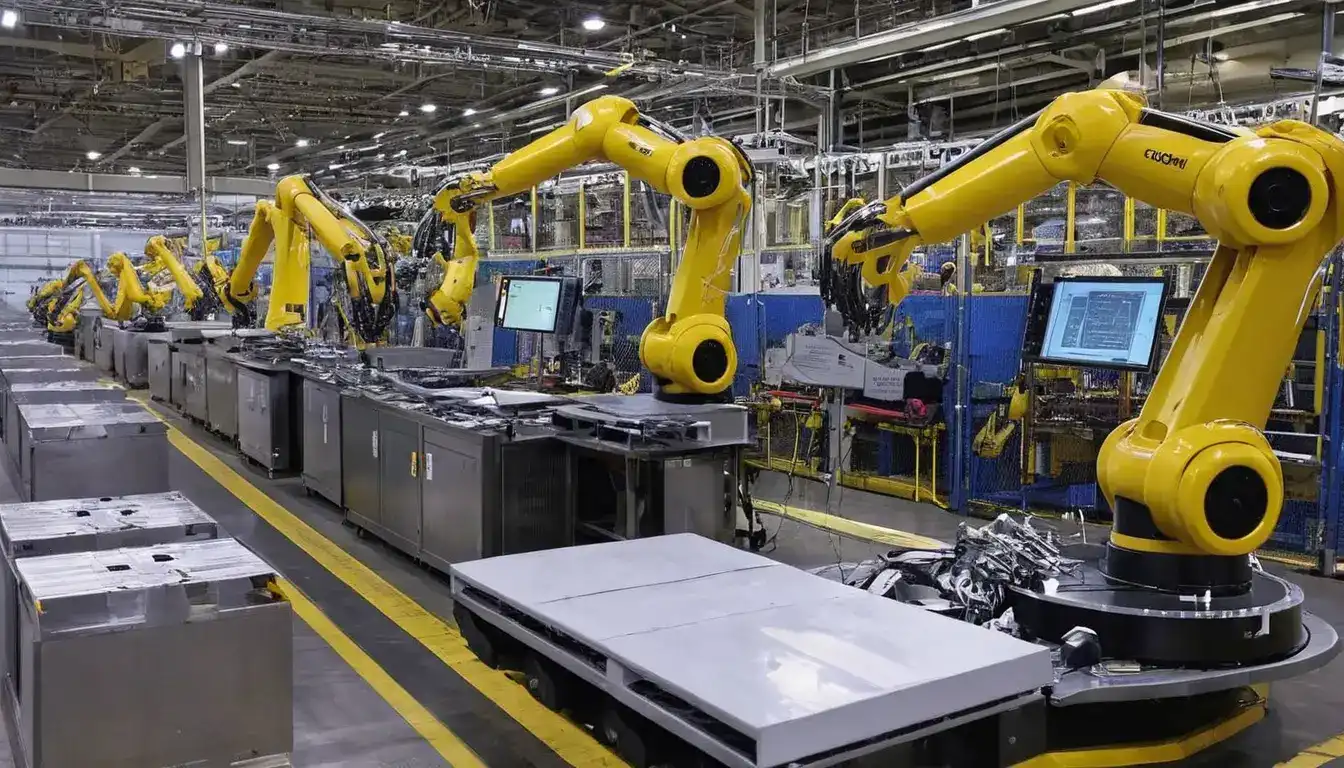Aggregate Demand/Supply: Core Concepts
Emily Willis

Photo: Aggregate Demand/Supply: Core Concepts
Understanding the Pulse of the Economy: Aggregate Demand and Supply Explained
The economy, much like a living organism, breathes and pulsates with activity. From the daily grocery runs to multi-billion-dollar infrastructure projects, countless transactions occur, shaping our collective economic reality. To truly grasp the forces at play, economists use powerful concepts: Aggregate Demand and Aggregate Supply. These aren't just academic terms; they are the fundamental pillars that help us understand everything from inflation and unemployment to economic growth and recessions.
For a general audience, understanding these core concepts provides a clearer lens through which to view economic news, understand policy decisions, and even anticipate shifts that might affect personal finances and career paths. This article will demystify aggregate demand and supply, explain their components, and reveal how their interplay dictates the overall health and direction of an economy.
Understanding Aggregate Demand: The Economy's Total Appetite
Imagine an entire nation's desire for goods and services. This isn't just about what one person wants, but the sum total of what everyone in the economy – households, businesses, governments, and even foreign buyers – is willing and able to purchase at various price levels over a specific period. This grand total is what economists refer to as Aggregate Demand (AD).
Think of it as the total spending power in an economy. When aggregate demand is strong, it signals a robust economy with plenty of purchasing activity. Conversely, a weak aggregate demand can be a sign of economic slowdown.
Components of Aggregate Demand
Aggregate Demand is typically broken down into four main components, often represented by the formula: AD = C + I + G + (X - M).
-
Consumption (C): This is the largest component of aggregate demand, representing all spending by households on goods and services. This includes everything from your daily coffee and groceries to new cars and vacations. Factors like disposable income, consumer confidence, interest rates, and expectations about future prices significantly influence consumption patterns. For example, if people feel secure in their jobs and expect higher future incomes, they tend to spend more.
-
Investment (I): This refers to spending by businesses on capital goods, such as new factories, machinery, equipment, and technology. It also includes residential construction. Investment is crucial for long-term economic growth as it expands the economy's productive capacity. Interest rates, business confidence, and technological advancements are key drivers of investment. When businesses are optimistic about the future, they are more likely to invest, boosting aggregate demand.
-
Government Spending (G): This includes all spending by local, state, and federal governments on goods and services. Examples range from building roads and schools to defense spending and public employee salaries. Government spending is influenced by fiscal policy decisions and political priorities. An increase in government spending directly injects money into the economy, increasing aggregate demand.
-
Net Exports (X - M): This is the difference between a country's total exports (X) and its total imports (M). Exports are goods and services produced domestically and sold to foreign buyers, while imports are foreign-produced goods and services bought by domestic consumers.
- Exports (X): When foreign economies are thriving, they demand more of our goods and services, increasing exports and thus aggregate demand.
- Imports (M): When domestic consumers buy more foreign goods, it reduces the demand for domestically produced items, lowering net exports.
- Factors like exchange rates and global economic conditions play a significant role in net exports. A weaker domestic currency, for instance, makes exports cheaper and imports more expensive, potentially boosting net exports and aggregate demand.
Factors Influencing Aggregate Demand Shifts
Changes in any of the components above, or broader economic factors, can cause the entire aggregate demand curve to shift.
- Consumer Confidence: If consumers are optimistic about the future, they spend more, shifting AD to the right. Conversely, fear of recession shifts AD to the left.
- Interest Rates: Lower interest rates make borrowing cheaper, encouraging consumption (e.g., car loans, mortgages) and investment (business expansion), shifting AD to the right. Higher rates have the opposite effect.
- Government Policies (Fiscal & Monetary):
- Fiscal Policy: Government decisions on spending and taxation directly influence AD. Increased government spending or tax cuts boost AD, while spending cuts or tax hikes reduce it.
- Monetary Policy: Central banks influence the money supply and interest rates. Lowering interest rates (expansionary monetary policy) encourages borrowing and spending, shifting AD to the right.
- Exchange Rates: A weaker domestic currency makes exports more attractive and imports less so, increasing net exports and shifting AD to the right.
- Foreign Income: If major trading partners experience economic growth, their demand for our exports increases, shifting our AD to the right.
- Wealth Effect: An increase in household wealth (e.g., rising stock market or property values) can make consumers feel richer and spend more, boosting AD.
Demystifying Aggregate Supply: The Economy's Production Powerhouse
While aggregate demand represents the economy's appetite, Aggregate Supply (AS) represents its ability to produce. It is the total quantity of goods and services that firms in a national economy are willing and able to produce and sell at different price levels during a specific period. In essence, aggregate supply is the nation's total output, or real Gross Domestic Product (GDP).
Short-Run vs. Long-Run Aggregate Supply
A critical distinction in understanding aggregate supply lies between the short run and the long run:
- Short-Run Aggregate Supply (SRAS): In the short run, some input prices, particularly wages, are "sticky" or slow to adjust. This means that if the overall price level of goods and services in the economy rises, but wages remain relatively fixed, firms experience higher profits per unit of output. This incentivizes them to increase production by using existing resources more intensively (e.g., overtime for workers). Therefore, the SRAS curve typically slopes upward, indicating that a higher price level generally leads to a greater quantity of output supplied in the short run.
- Long-Run Aggregate Supply (LRAS) and Potential Output: In the long run, all input prices, including wages, are fully flexible and can adjust to changes in the overall price level. The Long-Run Aggregate Supply (LRAS) curve is a vertical line at the economy's potential GDP or full employment output. This represents the maximum sustainable output an economy can produce when all resources (labor, capital, technology, natural resources) are fully employed and utilized efficiently, without accelerating inflation. In the long run, the level of output is determined by the economy's productive capacity, not by the price level.
Factors Influencing Aggregate Supply Shifts
Shifts in aggregate supply, particularly the SRAS, can significantly impact the economy. Factors that affect the cost of production or the availability of resources can cause these shifts.
- Input Prices: Changes in the cost of crucial inputs like labor (wages), raw materials (e.g., oil), or energy can shift AS. For example, a significant increase in oil prices makes production more expensive for many industries, shifting SRAS to the left. Conversely, a decrease in input prices shifts SRAS to the right.
- Productivity: Improvements in technology, education, or efficiency that allow firms to produce more output with the same amount of inputs (or the same output with fewer inputs) increase productivity. This shifts both SRAS and LRAS to the right, indicating greater productive capacity.
- Quantity and Quality of Resources:
- Labor: An increase in the labor force or an improvement in worker skills (human capital) shifts AS to the right.
- Capital: More or better machinery, factories, and infrastructure increase productive capacity, shifting AS to the right.
- Natural Resources: Discovery of new resources or depletion of existing ones can shift AS.
- Government Regulations and Taxes: Policies that increase the cost of doing business (e.g., stricter environmental regulations, higher business
Latest ✨
View AllDitch stressful tests! Gamified assessment makes evaluations fun, fair & future-ready. Unlock true potential with engaging, insightful methods.
Emily Willis
secrets to mastering your business financial plan with five simple steps. Learn how to analyze financial data, set measurable goals, and create a comprehensive strategy for success. Unlock profitability, make confident decisions, and ensure a bright future for your business
Emily Willis
Europe is full of rich culture, with ten cities offering enriching cultural experiences. From the romance of Paris to the splendor of Rome and the artistic flair of Barcelona, each city has its own unique charm and heritage.
Emily Willis
invitation to go on a wildlife safari through Kenya, Tanzania, and Australia. It describes the unique wildlife encounters in each country, such as witnessing the Great Migration in Kenya, exploring the Serengeti in Tanzania, and encountering koalas and kangaroos in Australia.
Emily Willis
Business
View All
June 9, 2025
Innovation Strategy for Future BusinessInnovation is vital for future business success. Learn why a robust strategy ensures survival, growth, and competitiveness in a changing world.
Emily Willis

June 8, 2025
Importance of Corporate GovernanceCorporate governance isn't just for boardrooms. Understand its vital role in ethical business, trust, and sustainable growth for all stakeholders.
Emily Willis

June 9, 2025
Succeed with SaaS Business ModelMaster the SaaS business model! This guide reveals strategies for building a thriving enterprise, from understanding the landscape to achieving product-market f...
Emily Willis
Economy
View AllUnpack the immense power of central banks and how they're held accountable for shaping the economy and your financial life.
Read MoreTechnology is now an integral part of our daily lives and economies, driving innovation, boosting productivity, and fueling economic growth. It streamlines research and development, facilitates collaboration, automates mundane tasks, and democratizes innovation.
Read MoreThe inflation threat explained. Understand its causes and discover effective cures to protect your purchasing power and navigate economic challenges.
Read MoreEntertainment
View All
August 5, 2024
Classic Films: Timeless Masterpieces in the Age of StreamingClassic films may seem outdated in today's world of instant gratification and endless streaming options, but they offer enduring stories, masterful storytelling, historical insights, technical innovation, and artistic value that surpass modern offerings. While classic films face challenges such as accessibility and pacing, there are ways to overcome these obstacles, such as using streaming services, visiting local libraries, attending film festivals, and utilizing online resources.
Emily Willis

August 4, 2024
The Latest Music Trends, Artists Influencing Pop Culture, and How Digital Platforms Facilitate the Distribution of Music GloballyThe music industry is constantly changing due to consumer preferences, technology, and the influence of artists. Digital platforms have revolutionized music creation, distribution, and consumption, leading to genre fusion, the rise of independent artists, and collaborative projects. Influential artists like Billie Eilish, BTS, and Taylor Swift have shaped pop culture globally. Streaming services, social media, and direct-to-fan engagement have transformed music distribution. Digital platforms also promote cultural diversity and inclusivity, expand markets and revenue, and drive technological advancements. The industry is also focusing on sustainability and ethical practices. To succeed in the future, stakeholders must embrace digital transformation and champion inclusivity.
Emily Willis

August 5, 2024
Entertainment in Society: Social Impact, Cultural Influence, Economic ContributionsEntertainment is more than just a way to pass the time it has a significant impact on society, culture, and the economy. It promotes empathy, sparks conversations, and drives social change. It reflects and shapes cultural trends, while also preserving traditions. The entertainment industry generates jobs, contributes to economic growth, and drives technological innovation.
Emily Willis
Health
View AllRegular exercise is essential for maintaining both physical and mental health. It helps with weight management, cardiovascular health, muscle strength, energy levels, and sleep quality. Exercise also reduces stress and anxiety, improves mood, cognitive function, and self-esteem, and lowers the risk of depression. Different types of exercises, such as aerobic, strength training, flexibility, balance, and mind-body exercises, contribute to overall health. To start and maintain an exercise routine, it is important to start slowly, set realistic goals, find enjoyable activities, stay consistent, and listen to your body.
Emily Willis
Maintaining good health involves a balanced diet that provides essential nutrients for the body. A balanced diet includes carbohydrates, proteins, fats, vitamins, minerals, fiber, and water. Benefits of a balanced diet include enhanced energy levels, improved mental health, a stronger immune system, better weight management, reduced risk of chronic diseases, and enhanced digestion. Components of a balanced diet include fruits and vegetables, whole grains, protein sources, dairy or dairy alternatives, and healthy fats. Tips for maintaining a balanced diet include planning meals, portion control, staying hydrated, limiting processed foods, eating mindfully, and including physical activity.
Emily Willis
sleep for physical and mental well-being, discussing the benefits of sleep such as physical restoration, brain function, emotional regulation, concentration, and reduced risk of chronic diseases. It explains the different stages of the sleep cycle and provides guidelines for how much sleep individuals of different ages need.
Emily Willis
Trending 🔥
View All
1
2
3
4
5
6
7
8
9
10
Sports
View AllAugust 5, 2024
Celebrating Sports Legends: Honoring Iconic Figures and Their Enduring Impact
Read MoreAugust 4, 2024
The Importance of Mental Training and Psychological Strategies in Helping Athletes Reach Their Peak Performance on the Field
Read MoreTechnology
View All
August 4, 2024
AI-Powered Robots Take Over Manufacturing Jobs: Is Our Workforce Prepared?
AI-powered robots are transforming the manufacturing industry, leading to increased efficiency and improved product quality. While concerns about job displacement exist, AI is more likely to transform jobs rather than eliminate them.

August 5, 2024
Challenges and Opportunities in Implementing IoT Technology
The Internet of Things (IoT) is revolutionizing industries by enabling real-time monitoring, automation, and decision-making. However, implementing IoT technology comes with challenges such as security concerns, interoperability issues, data management, scalability, and cost. Despite these challenges, IoT offers opportunities for operational efficiency, enhanced customer experience, innovation, environmental sustainability, and business intelligence.

August 5, 2024
Tips for Keeping Your Personal Data Safe on the Internet
The digital age has made personal data more vulnerable to threats such as phishing, hacking, identity theft, and data breaches. To protect yourself, it is important to create strong passwords, be cautious of phishing attacks, secure your devices, safeguard your personal information online, practice safe online shopping and banking, protect your social media accounts, and stay informed about cybersecurity threats.

August 5, 2024
The Future of Cybersecurity and Upcoming Challenges
cybersecurity in the digital age, highlighting key trends and challenges that will shape the future of cybersecurity. It addresses issues such as the increased use of AI and ML, the growth of IoT devices, ransomware attacks, cloud security, and supply chain attacks. It also outlines upcoming challenges in cybersecurity, including talent shortage, regulatory compliance, cybersecurity for remote work, quantum computing, and social engineering attacks.





















